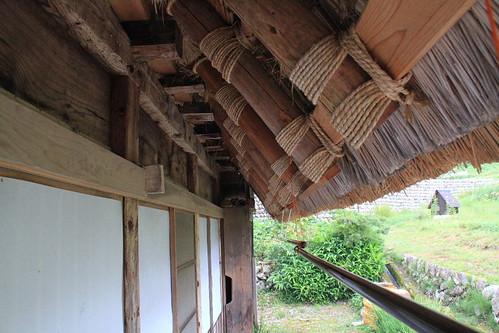
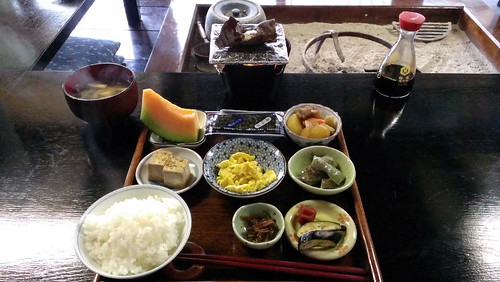
The night in Shirakawa-go is pretty comfortable and cool, and I had a nice sleep yesterday.
Around five o'clock, I've already woken up and sit on the outdoor corridor watching the morning scene.
The breakfast looks a little similar to Taiwan traditonal breakfast, though we eat the rice porridge instead of rice.
The salted raw enggplant tastes special just like a fruit.
As for the Hoba Miso heated on the small stove, that is good as accompanied with rice.
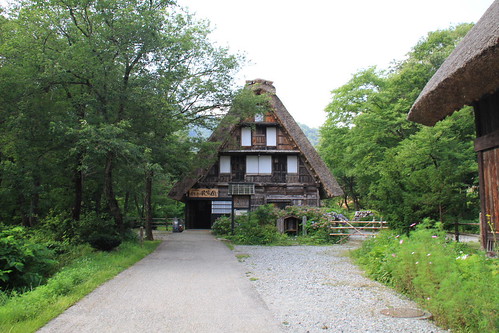
Because the bus to Takayama is around ten o'clock, we go visiting the open-air museum near the tourist center.
Gassho-zukuri Minkaen was established in 1967 for preserving Gassho-zukuri farmhouses is Kazura village where all the inhabitants left for earning their living in other places.
At that time, the society and economy were changed. Niter was replaced by Chilean nitrate, and the factory is much powerful than local farmers. Even the chemical fiber became common to replace the silk.
Due to such reason, the project was erected and relocated the farmhouse to Ogimachi.
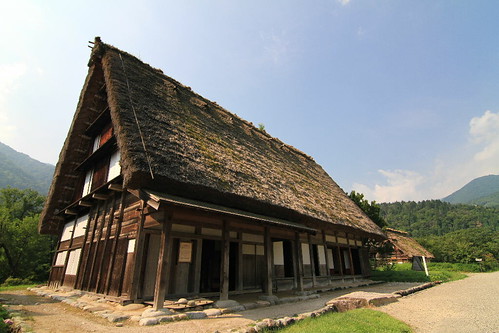
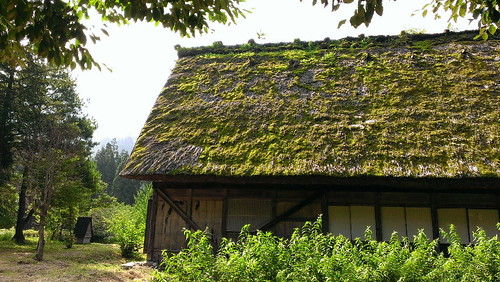
Although it's an open-air museum, this museum is different from other museums as you image.
These preserved farmhouses are worth visiting.
Except for the normal farmhouses, there are also warehouse, shirine, watermill and etc.
The grass on the roof makes the house looks ancient and historic.
Every house seems to have their own personality with different looking.
Among these farmhouses, Yamashita house is the oldest one in Ogimachi.
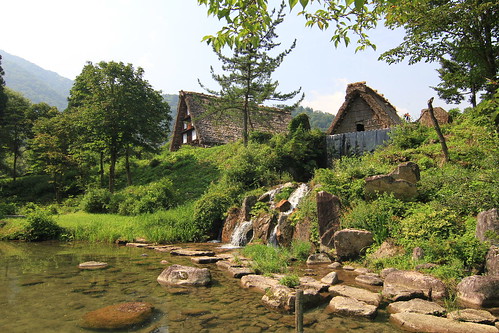

Of course, the museum-style houses may not show the real life as the farmhouses I visited yesterday.
However, the surroundings, such as garden, pond and river, make the view scenic and special.
Anyway, it's a nice spot for photographing the gassho-zukuri houses with different styles.
Before reaching the exit, the staff nearby would take photos for you with your camera, and also sell the picture of you in a reasonable price.
Sometimes, I would like to pay for these souvenirs as the support for the museum, the church or the historic remains.
With the financial support from tourism, it would be very helpful for them to keep and maintain these buildings.
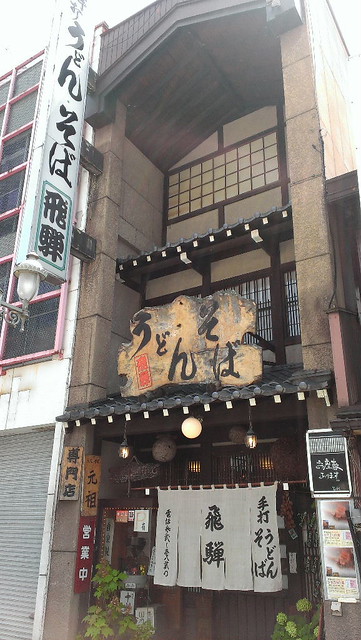

Getting on the bus back to Takayama, I look for a soba restaurant before we go to Hida Furukawa in the afternoon.
I really like the hand-made soba and there is just such a restaurant near the station.
In such a hot day, cold soba or udon is an ideal choice for the lunch.
Looking at the menu on the wall, you might wonder how to order the dishes.
Don't worry. They also offer the English menu with pictures.
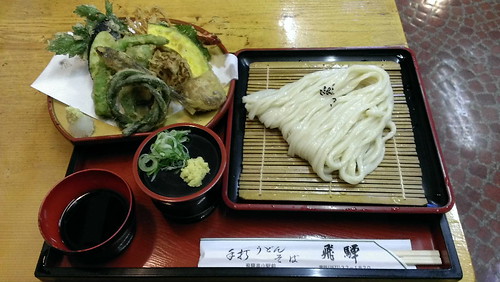
In Japan, while referring to soba, it means soba in the soup mostly.
If you prefer the cold soba without soup, you should look for the keyword "ざる" (Zaru).
Zaru is a draining basket made from bamboo used in the preparation and presentation of Japanese cuisine.
No doubt, Zaru soba could not be the soba in the soup, and is for sure the cold soba.
Maybe some restaurant would not adopt the same name, but they will understand what you want.
Therefore, my lunch is the Zaru Udon with Tempura (天ざるうどん, Tem-Zaru-Udon). It's really tasty!
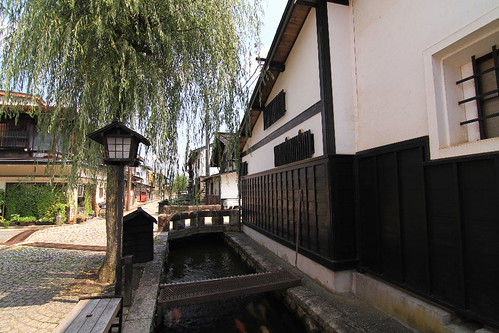
After the lunch, we take the JR train to Hida Furukawa.
It takes about 16 to 20 minutes depending on the type of the train, though you don't have too many choices.
Furukawa is smaller and calmer than Takayama.
The nicely preserved old town and the famous Furukawa Festival are the main features.
As for the old town area, the main point is the street along the Seto river where you could see the warehouses with white walls.
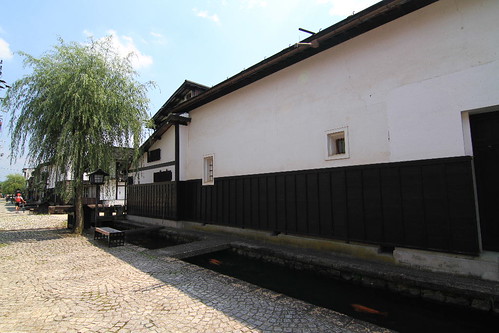
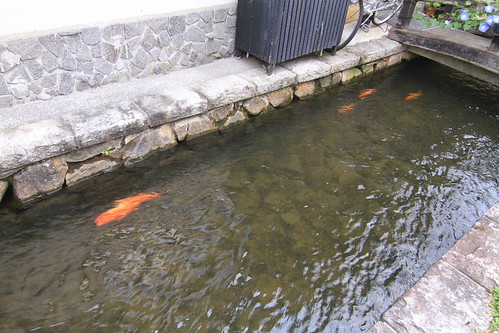
The Seto river is actually a canal in which inhabited by many carps.
It's quite interesting. You could buy the fish food for 100 Yen and see how these carps open their mouths while you feed them.
In the past, this waterway was a boundary to separate the town's merchants' block from samurai warriors' block.
Besides, the water was also for drinking, daily use and irrigation. Nowadays, the water is used for extinguishing fires.
This long street with three main blocks is lined by warehouses with white plaster walls.
The warehouses are belonging to a three hundred year-old sake brewery, and private homes.
Why there are carps swimming in Seto river?
It's said that these carps are helpful to reduce the garbage from human, and the carps are also the indication of the water quality.
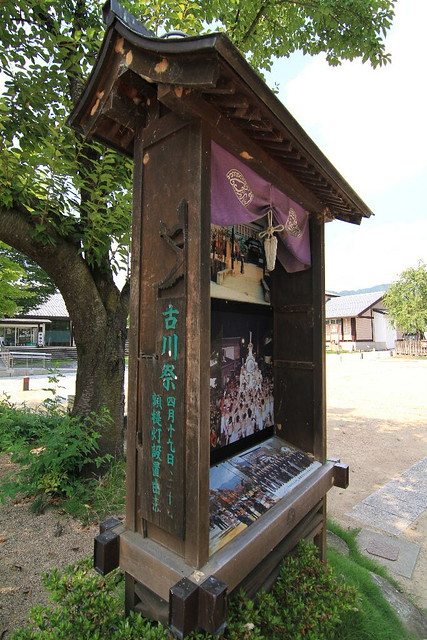
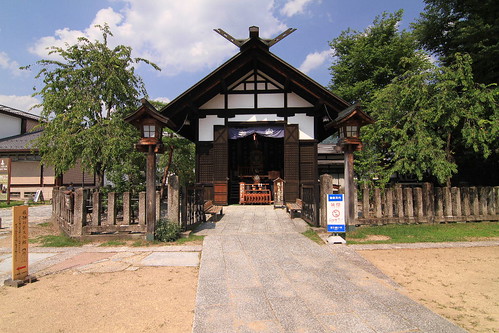
Reaching the end, you would see the shirne on your right where is the place Furukawa Festival is held every April 19th and 20th.
On these days, the people would play large drums called Okoshi-daiko.
The men are barely dressed, and moving the tall, beautifully decorated floats through Furukawa Town to show their strength and masculinity.
If you are interested in this festival, you could visit Hida Furukawa Festival Hall nearby.
Besides, the Takumikan Craft Museum would show you the traditional Hida craftsmanship.

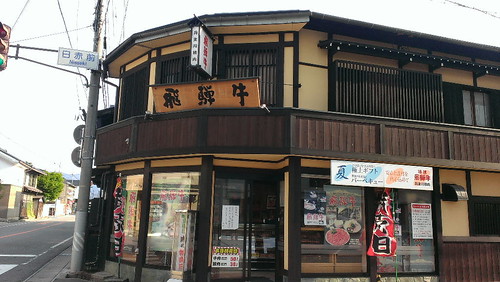
Finishing the stroll in Furukawa, we come back to Takayama.
All the attractions around this mountain area are all completed, and finally we will look around Takayama tomorrow.
In the late afternnon, except for buying some ingredients in the supermarket, I go to the beef shop for the delicious chunk of Hida beef.
This shop is located between Zenkoji and Hida Tenmangu shrine, and shown as location B on the map above.
Of course, the 5A grade Hida beef is my only target, and the price is 3300 Yen for 200 gram that is only the half price of the restaurant.
By the way, the best Hida beef here is 2500 Yen for 100 gram. I think I will try it tomorrow.

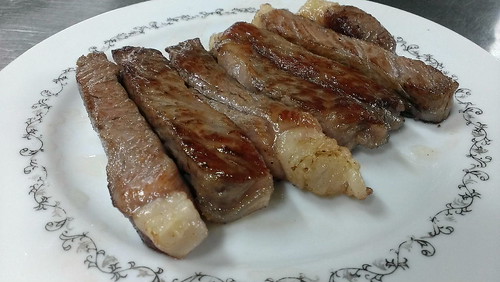
For me, preparing steak is always a simple job. The only main point is controlling the fire and the time.
Medium is for sure the recommended level for the best taste of any beef.
Because the Hida beef is rich in fat, you don't need other oil for the pan but the shop also give you the beef oil for cooking.
I'm quite satisfied with my steak dinner.
No matter how many times I chew the Hida beef, the delicious flavor that melts in the mouth always makes me feel great and happy.
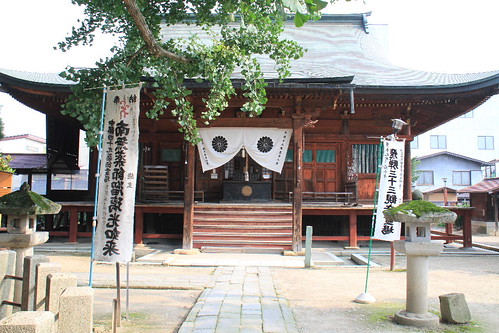
In the morning tomorrow, our trip in Takayama starts from Miyagawa Morning Market.
Going northwards from Zenkoji, you will reach the Kokubunji-dori street with many shops and restaurants.
Because these facilities don't open at this time, we visit Hida Kokubunji Temple first.
Hida-Kokubunji Temple was built in 746AD, during Japan's Nara period, by Emperor Shomu to pray for the nation's peace and prosperity..
Temples of this type were fairly common in Japan, and there are also 60 temples in existence.
The main Buddha of Kokubunji is Yakushi Nyorai, commonly referred as "Medicine Buddha".
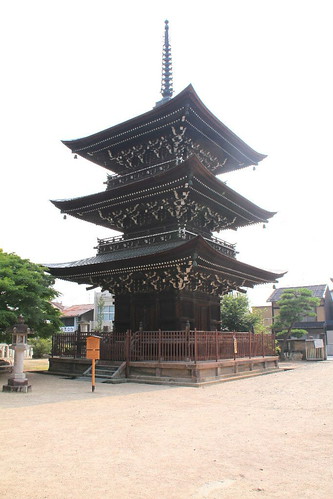
Except for the main hall which is the nationala cultural treasure, the three-storied pagoda is the only one of its style in Hida.
This pagoda was once a seven-storied tower but disminished due to the war and disaster.
What we see nowadays is an Edo period reproduction of the original in 1821.
Besides, the large ginkgo tree beside the main hall is a designated national monument.
It's said to be 1,200 years old.
If you look carefully, you will find a small stone budda embedded on the tree trunck.
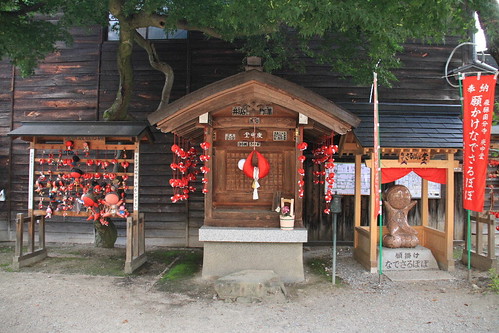
At the entrance of Kokubunji, you may also find interesting red dolls.
These dolls are called Sarubobo (身代わり猿) that means monky baby.
Sarubobo is the special mascot of the Hida Region.
People will hang the doll at this small shrine for praying wellness.
Saru in Japanese not only means monky, but also prevention.
Besides, the kanji "猿" (monky) is also pronounced the same as another Chinese word "圓".
"圓" is a good word for "圓滿" means "perfection" in Chinese.
By the way, people usually hang the Ema (絵馬), a small wooden plaque, for praying.
Only in Hida, people hang Sarubobo instead of Ema.
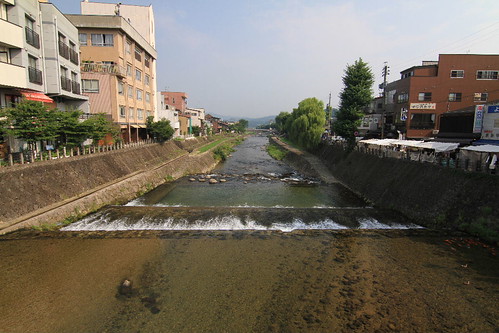
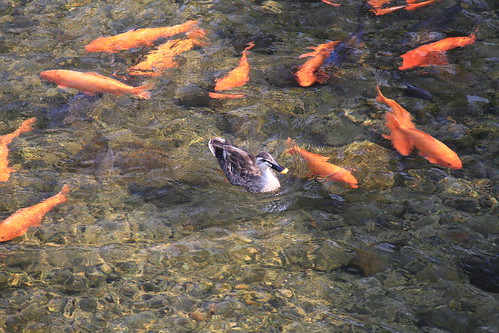
Not far from Kokubunji, You will see the Miyagawa and the morning market.
Mayagawa river is quite clear and bigger than Sento river in Furukawa.
Docks and carps are swimming in the river.
In Taiwan, I don't see any clear river in the city or town.
The water is not drinkable and there is no creature for sure.
So, I like these clear rivers of Japan very much.
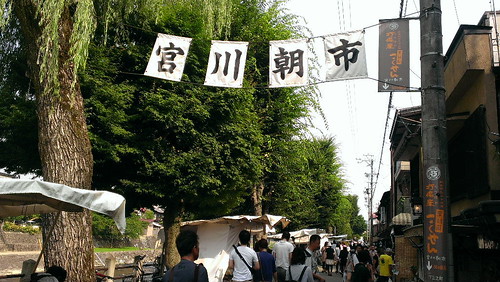
The stalls topped with white canvases is the feature of Miyagawa morning market.
This market started in the Edo period selling the fresh vegetables, fruits, refreshments, craft and etc.
It is one of the biggest morning markets in Japan.
If you didn't buy too much in the supermarket, I recommend you trying the fresh vegetables sold here.
The cucumber or eggplant I've tasted are really delicious even without being cooked.
Besides, you could also try the traditional Japanese spice called "七味粉" that is a mixed seasoning for every dishes.
The price here is quite cheap. A bag of vegetables may be only 100 Yen.
It's said the the number of stalls is decreasing gradually from 300 to 60.
After all, most of people are used to buy their daily stuff in the suprtmarket or convenience store.
If you don't support these stalls by shopping, this scene might disappear someday.

Going southwards from Miyagawa morning market, the next attraction is Sanmachi Old Streets.
This area is the nationally recognized important historical building preservation area in Takayama.
Most of the twon houses remain since Edo period, and some of the old private homes were converted into museums.
The feature of this kind of buildings is the latticed bay window stadning in a row, called kōshi.
Different styles of wooden lattices were once indicative of the type of shop.
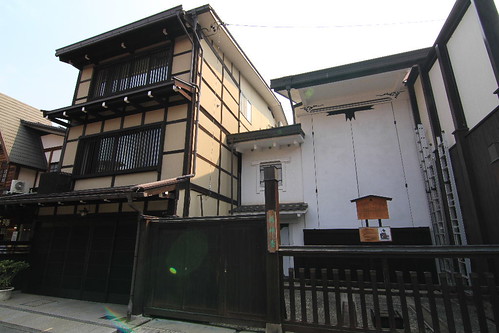
Except for the old twon houses, you may also see the tall storehouses for festival floats, such as Ryujintai (龍神台).
These floats would be displayed on the annual Spring Festival, Takayama Festival.
After the ritual ceremony at the Hie Shrine, the festival starts, and the beautifully decorated floats proceeds through the town in the night.
If you are interested in these floats, Festival Floats Exhibition Hall in Sakurayama Hachiman-gū (桜山八幡宮) houses 11 floats for the fall Takayama festival, and display 4 floats which would be changed on Mar, Jun and Sep.
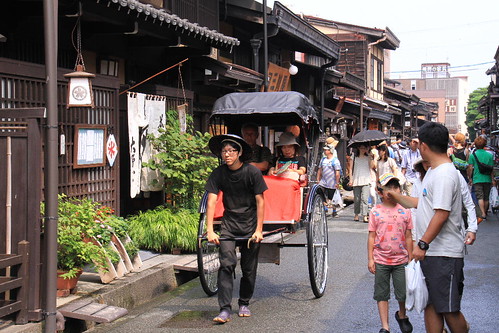

The old street is lined by every kind of shops including the sake breweries which offer free sake for tourists.
If you could understand Japanese, you might want to get on a man-pull cart listening to the introduction about this old twon area.
I'm not interested in the sake and specialty, but the roasted Hida beef sushi seems to be delicious.
In Taiwan, the beef sushi is also available and tasty.
Of course, I try two beef sushi with the cookie plate.
Hmm....I think if the source could be lighter, the taste of the beef would be better.
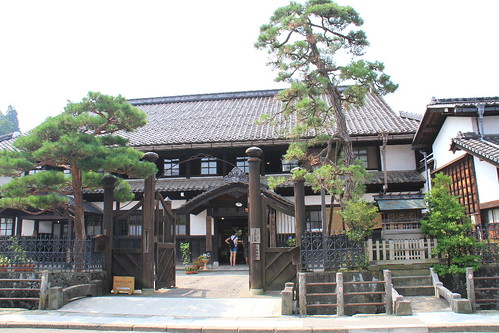
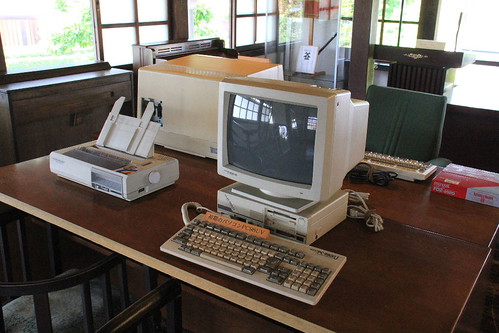
At the end of the old street is the Takayama City Memorial Hall.
It displays the local history, culture and the old city hall of Takayama city.
The building was built with the finest Japanese cypress and was the first Japanese architecture in Takayama that has glass sliding doors while glass windows were first introduced.
Besides, the roof architecture is also different from the traditional Japanese roof.
As the foreigners, we might not realize the old documents but the collections in the 2nd floor are nice.
For example, the old computer and related items are interesting.
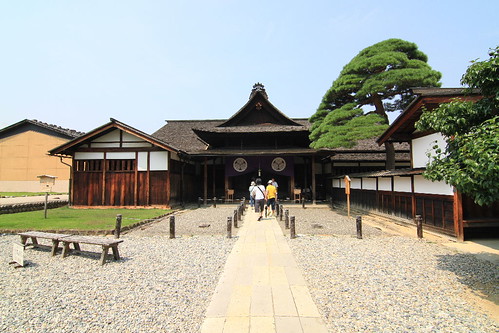
Before going back to Zenkoji for lunch, we visit Takayama Jinya as the final stop.
There is also a morning market in front of Jinya, but I prefer the scenic Miyagawa market.
Takayama Jinya (高山陣屋) is a former government outpost.
You could say that it was an officers' office with temporary accommodations, kitchens, a criminal court and other rooms for different use.
The building was originally belonged to Lord Kanamori as his villa.
However, it was rebuilt and served as offices in order to bring Hida under the direct control of the Edo Bakufu.
Now, Takayama Jinya is the only one of its kind in Japan.
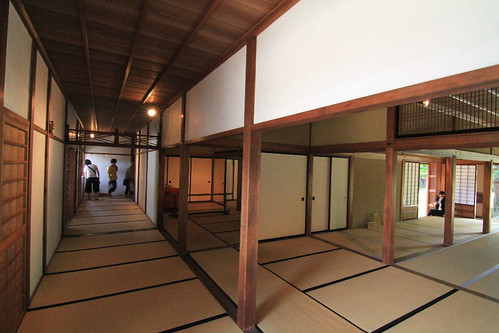
The main building was reconstructed in 1816.
Main officer's room is located in the center surrounding by other rooms used by the staffs.
This kind of arrangement is similiar to the army camp.
Because the main camp is called "本陣", I think that is why this building was named Jinya "陣屋".
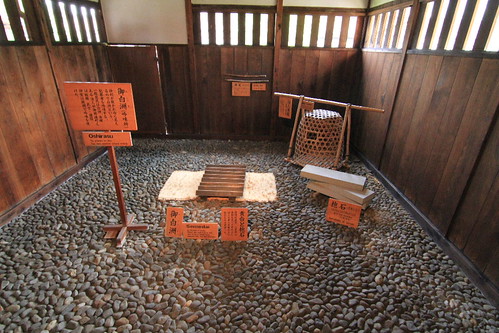
Most of the rooms are empty now, it's hard to image the lifestyle of the old goverment house.
So, you may only be interested in the tea perparation room, the kitchen or the criminal court.
In the tea room, there is a fish model as a device to adjust the length of the hanging bar for the tea pot.
The kitchen has numerous collections of the cooking utensils from the Edo period.
As for the criminal court, the instruments of torture are exhibited with the introduction of its use.
I think they should also restore the old items accompanied with the dummy.
As a museum, the tourists need more to realize the life in the ancient past.
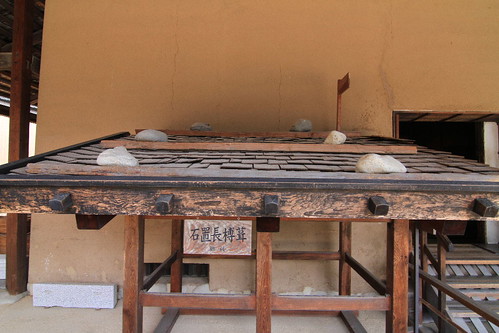
Along the guided path, the final one is the separated storehouse served as the museum for the collections of old documents, painting, armors and other treasurable items.
This storehouse is more than 400 years old. In the past, it was used to store rice that were paid as tax.
Due to the heavy snow in Hida, the roofs are coverd by wooden shingles in tree styles called Kurebuki.
Stones are put to hold the shingles and no nails are used.
You may see the demonstrations outsude the storehouse.
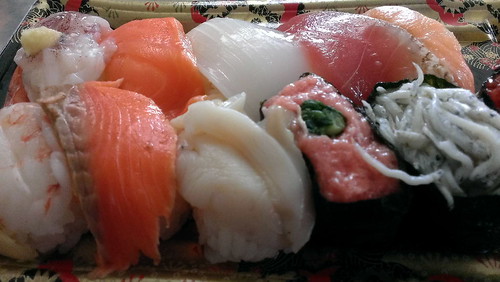
Coming back to Zenkoji, my lunch is the sushi box bought in the convenience store.
It's less than 500 Yen and the quality is even better than Kaiten sushi restaurant in Taiwan.
I really think that most of Japanese food is good in quality, such as sushi, buns, beef or vegetables.
Maybe the cost in Japan is really high, but the quality is worth paying such a price.
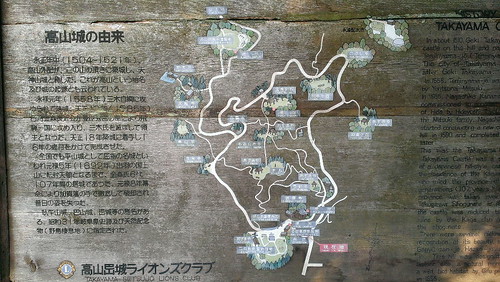
Because the afternoon is the hottest time in the day, we take a afternoon sleep in the room.
Until four to five o'clock, we just walk outside again to Shiroyama Park.
Shiroyama Park is a public park in the mountainous area around the ruins of Takayama Castle.
Just as Takayama Jinya, Takayama Castle was first built by Kanamori Nagachika and the control was finally transfered to Shogun.
Because the Edo Bakufu wanted to control the Hida area for its rich resourse, there was no Lord and Takayama Castle became the ruin.
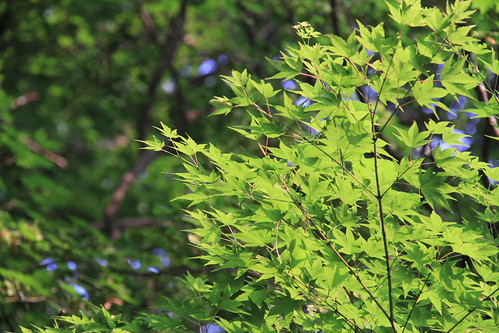

The most scenic seasons of Shiroyama Park should be Spring and Autumn.
The park has over 1000 cherry tree and the maples are also common.
In the summer, the tourists are few, but the park is still good for exercising.
A spot called "希望ヶ丘" (Kibougaoka) is a nice place to watch four bridges over Miyakawa river.
If you have more time, you could try the Higashiyama Walking Course from the park to Higashiyama Temple Area.
Numerous temples in this area were also built by Lord Kanamori, because he loved Kyoto.
The old town and the temple area were the reflection of Kyoto, and thus that is why Takayama is called "little Kyoto".
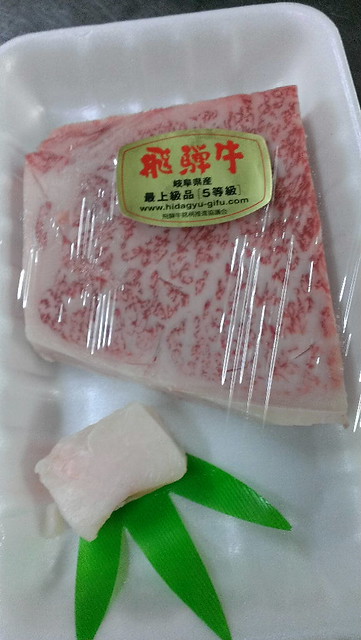
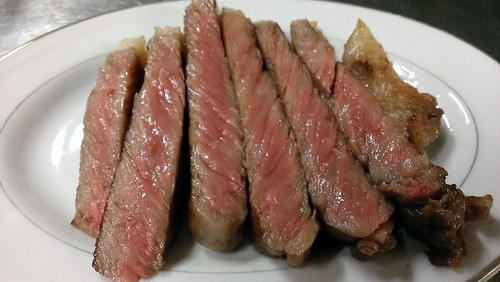
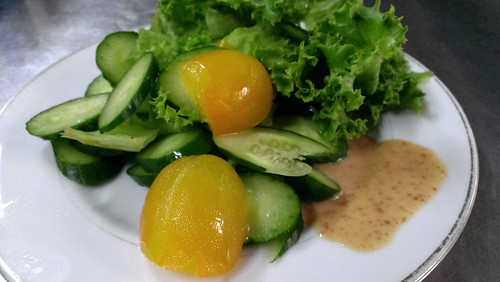
After the easy stroll in the park, it's time for my beef dinner.
Because we will leave Takayama tomorrow, it may be my last time to enjoy Hida beef.
Thus, I buy the best Hida beef of 200 gram for 5000 Yen.
If you ask me what the difference is, I think the balanced portion of oil is much better.
You may look at the medium beef I cooked, it's not disgusting completely.
Not too greasy and the beef melt in the mouth with wonderful flavor.
I also buy the sesame source in the shop that is good for the meat and vegetables.
It's recommended to buy some sources only sold in Japan.
I think you would also admire Japanese for their great products.
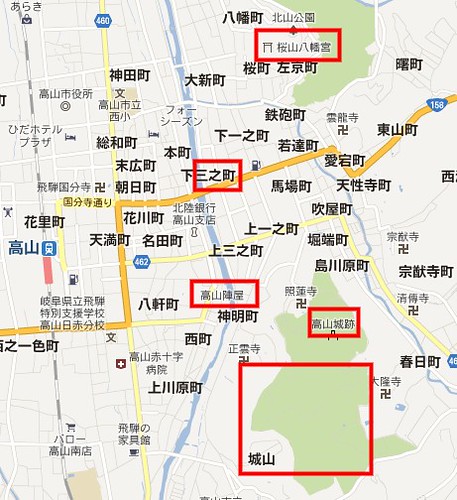
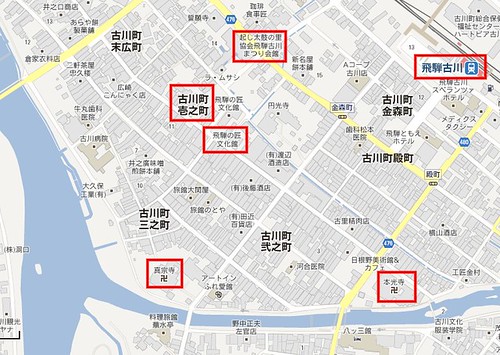
References:
http://www.japan-guide.com/e/e5951.html
http://en.wikipedia.org/wiki/Takayama,_Gifu
http://en.wikipedia.org/wiki/Takayama_Jinya
http://en.wikipedia.org/wiki/Shiroyama_Park_(Gifu)
http://en.wikipedia.org/wiki/Hida_Minzoku_Mura_Folk_Village
http://en.wikipedia.org/wiki/Hida,_Gifu
http://www.jnto.go.jp/eng/location/regional/gifu/hida_furukawa.html
http://www.japan-guide.com/e/e5975.html
http://www.japan-guide.com/e/e5978.html
http://www.japan-guide.com/e/e5907.html
http://www.satoyama-cycling.com/
http://www.hida.jp/english/dining/hida-beef
http://www.zipangguide.net/travel/sight/gifu/hidakokubun_temple.html
http://www.takayama-guide.com/sightseeing/temples_and_shrines.html
http://www.att-japan.net/en/spot/ES001300
http://en.wikipedia.org/wiki/Bhaisajyaguru
http://en.wikipedia.org/wiki/Acala
http://en.wikipedia.org/wiki/Amit%C4%81bha
http://en.wikipedia.org/wiki/Miso
http://shirakawago-minkaen.jp/
http://panoramahida.iza-yoi.net/shirakawagorekishi.html
http://en.wikipedia.org/wiki/Zaru
http://www.hida.jp/english/activities/area-attractions/setogawa-river-and-shirakabe-dozo-district
http://en.wikipedia.org/wiki/Ema_(Shinto)
http://en.wikipedia.org/wiki/Machiya
http://www.hida.jp/chinese/events/takayama-festival/sanno-matsuri-april


 留言列表
留言列表
